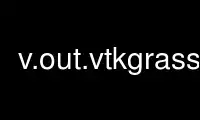
This is the command v.out.vtkgrass that can be run in the OnWorks free hosting provider using one of our multiple free online workstations such as Ubuntu Online, Fedora Online, Windows online emulator or MAC OS online emulator
PROGRAM:
NAME
v.out.vtk - Converts a vector map to VTK ASCII output.
KEYWORDS
vector, export, VTK
SYNOPSIS
v.out.vtk
v.out.vtk --help
v.out.vtk [-cn] input=name [layer=string] [output=name] [type=string[,string,...]]
[precision=integer] [zscale=float] [--overwrite] [--help] [--verbose] [--quiet]
[--ui]
Flags:
-c
Correct the coordinates to fit the VTK-OpenGL precision
-n
Export numeric attribute table fields as VTK scalar variables
--overwrite
Allow output files to overwrite existing files
--help
Print usage summary
--verbose
Verbose module output
--quiet
Quiet module output
--ui
Force launching GUI dialog
Parameters:
input=name [required]
Name of input vector map
Or data source for direct OGR access
layer=string
Layer number or name
Vector features can have category values in different layers. This number determines
which layer to use. When used with direct OGR access this is the layer name.
Default: 1
output=name
Name for output VTK file
type=string[,string,...]
Input feature type
Options: point, kernel, centroid, line, boundary, area, face
Default: point,kernel,centroid,line,boundary,area,face
precision=integer
Number of significant digits (floating point only)
zscale=float
Scale factor for elevation
Default: 1.0
DESCRIPTION
v.out.vtk converts a GRASS vector map in binary format to the VTK ASCII output.
If the output parameter is not given, the output will be send to stdout.
NOTES
The following vector types can be exported together in one VTK ascii file:
· point
· line
· centroid
· boundary
· area
· face
Category data (cat) for the selected vector type and layer will be written as scalar data
with name "cat_{vectorname}". If no cat exists, the value will set to -1 as normal cat’s
are always positive. If a vector has more categories in one layer, only the first
category will be exported.
3d vectors are supported by default. The created VTK data always includes x, y and z
coordinates (z = 0 if not a 3d vector map). Note that you can easily convert your 2d
vectors into 3d vectors with v.drape.
Because of the 32bit limits of OpenGL which is used by VTK, visualisation errors may
occure if the grass region contains coordinates greater than 1.000.000 and vector
coordinates with 0.01 - 0.001 meters precisison. For this reason, the flag "-c" was added.
The coordinates are transformed to smaller coordinates (by decreasing the coordinates with
the region center).
If the "-c" flag is used and the data should be visualised together with other data
exported via *.out.vtk modules, be sure the "-c" flag was also set in these modules. But
this will only work with data from the SAME location (The reference point for the
coordinates transformation is based on the default region).
The GRASS vector data is converted into the polydata format of VTK:
· vtk Vertices -- representing points and centroids
· vtk lines -- representing lines and boundaries
· vtk polygons -- representing areas and faces
The VTK file can be visualized with VTK Toolkit, Paraview and MayaVi.
Attention
If areas or faces are exported, the data have to be triangulated within Paraview or
MayaVi.
EXAMPLE
Spearfish example:
Export the soils with cats in layer 1:
v.out.vtk input=soils type=area layer=1 output=/tmp/soils.vtk
Export the streams with cats in layer 1:
v.out.vtk input=streams type=line layer=1 output=/tmp/streams.vtk
Write the archsite vtk output to stdout with cats in layer 1:
v.out.vtk input=archsites type=point layer=1
Use v.out.vtkgrass online using onworks.net services
